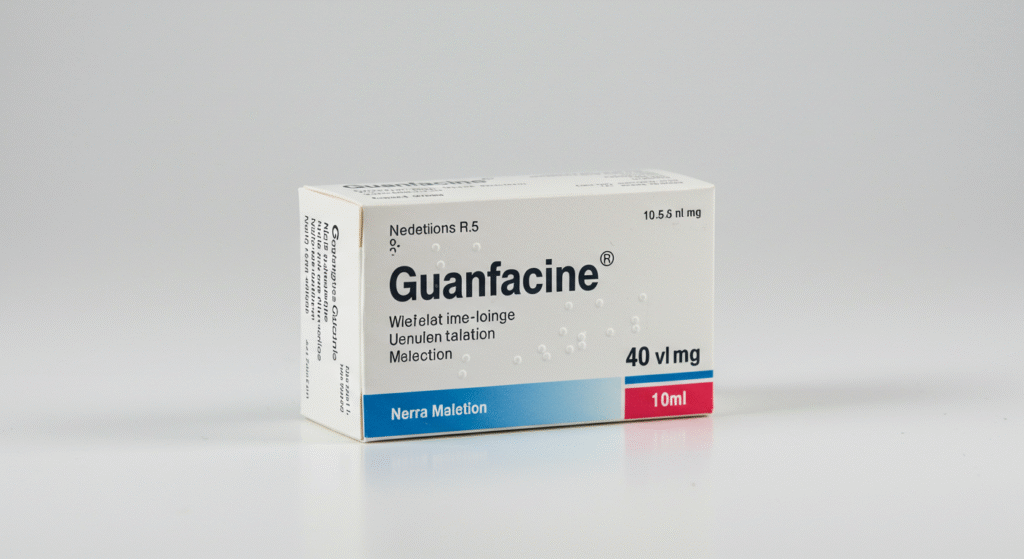Understanding Guanfacine: Uses, Benefits, and Potential Side Effects
Commonly prescribed under brand names like Intuniv and Tenex, is a non-stimulant medication used primarily to treat Attention-Deficit/Hyperactivity Disorder (ADHD) and high blood pressure. Its calming effects help improve attention, impulse control, and emotional regulation, making it a valuable option for individuals who do not respond well to stimulant medications. This guide explores everything you need to know about it, its uses, dosage, benefits, and potential side effects.

What is Guanfacine?
It is an alpha-2A adrenergic receptor agonist. Originally developed to treat high blood pressure, it is now widely used to manage ADHD symptoms. It works by affecting receptors in the brain to reduce hyperactivity and impulsivity while enhancing attention and executive functioning.
Brand Names:
- Intuniv: Extended-release formulation for ADHD
- Tenex: Immediate-release formulation used off-label for ADHD or hypertension
How Guanfacine Works
It targets alpha-2A receptors in the prefrontal cortex, the area of the brain responsible for executive functions like attention, impulse control, and decision-making. By stimulating these receptors, it enhances brain connectivity, helping to regulate emotional responses and improve focus.
Unlike stimulants, which act on dopamine and norepinephrine, guanfacine primarily affects the noradrenergic system, leading to a calming effect that helps reduce symptoms of ADHD.
Medical Uses
1. Treatment of ADHD:
- Reduces hyperactivity and impulsivity.
- Enhances attention span and focus.
- Helps regulate mood and emotional outbursts.
- Commonly prescribed for children and adolescents but can be used in adults.
2. Treatment of High Blood Pressure:
- Lowers blood pressure by relaxing blood vessels and reducing heart rate.
3. Off-Label Uses:
- Anxiety disorders
- Sleep disorders (due to its sedative effects)
- Tourette syndrome or tics
Key Benefits
- Non-Stimulant: Ideal for individuals who experience side effects from stimulant medications.
- Long-Lasting Effects: The extended-release form (Intuniv) provides symptom relief throughout the day.
- Calming Properties: Helps with sleep disturbances, anxiety, and emotional regulation.
- Low Abuse Potential: Unlike stimulants, this non stimulant is not associated with addiction or misuse.
Dosage and Administration
Typical Dosage Guidelines:
- Children (Ages 6-12): Start with 1 mg once daily, typically in the evening, and gradually increase by 1 mg per week as needed. The maximum dose is usually 4 mg/day.
- Adolescents (Ages 13-17): The same initial dosing schedule applies, with potential adjustments based on effectiveness.
- Adults: Dosing varies but often follows a similar gradual increase.
Important: Follow your healthcare provider’s instructions. Do not stop taking it suddenly, as this may cause withdrawal symptoms like increased heart rate or high blood pressure.
Potential Side Effects
While it is generally well-tolerated, some individuals may experience side effects. These typically diminish over time or with dosage adjustments.
Common Side Effects:
- Fatigue or drowsiness
- Dizziness or lightheadedness
- Dry mouth
- Headaches
- Low blood pressure
- Nausea
Less Common but Serious Side Effects:
- Slow heart rate (bradycardia)
- Fainting
- Mood changes (irritability or depression)
- Rebound hypertension (if discontinued abruptly)
Managing Side Effects:
- Taking it at bedtime to reduce daytime drowsiness.
- Stay hydrated and monitor blood pressure regularly.
Who Should Avoid Guanfacine?
The drug may not be suitable for everyone. Inform your doctor if you have any of the following conditions:
- Low blood pressure or heart problems
- Liver or kidney disease
- A history of fainting
- Depression or severe mood disorders
Additionally, it may interact with other medications, including sedatives, blood pressure medications, and certain antidepressants. Always provide your healthcare provider with a complete list of your medications.
Guanfacine vs. Other ADHD Medications
Guanfacine vs. Stimulants (e.g., Adderall, Ritalin):
- Mechanism of Action: It works on alpha-2A receptors, while stimulants target dopamine and norepinephrine.
- Onset and Duration: It has a slower onset but provides long-lasting effects. Stimulants work quickly but may cause fluctuations throughout the day.
- Side Effects: Is less likely to cause insomnia or appetite suppression.
- Abuse Potential: Has a lower risk of misuse compared to stimulants.
Guanfacine vs. Clonidine:
- Both medications belong to the same drug class and work similarly.
- Guanfacine has a longer half-life, providing more sustained effects and fewer doses throughout the day.
- Clonidine may cause more sedation and is typically used when sleep disturbances are a primary concern.
Frequently Asked Questions
1. How long does it take to work?
Guanfacine may take 1-2 weeks to show noticeable improvements in ADHD symptoms, with full effects often seen after 4-6 weeks.
2. Can guanfacine help with sleep problems?
Yes, guanfacine’s sedative properties make it helpful for individuals with ADHD who have trouble falling or staying asleep.
3. Is guanfacine addictive?
No, guanfacine is not classified as a controlled substance and has a low risk of dependence.
4. Can guanfacine be taken with other ADHD medications?
Yes, it is often prescribed alongside stimulants for individuals who need additional symptom control or help with sleep and anxiety.
Tips for Maximizing the Effectiveness of Guanfacine
- Take It Consistently: Adhere to a regular dosing schedule for the best results.
- Monitor Progress: Keep track of symptom improvements and any side effects.
- Combine with Therapy: Behavioral therapy and counseling can enhance the medication’s effectiveness.
- Stay Hydrated: Drink plenty of water, especially if you experience dizziness or dry mouth.
Final Thoughts: Is Guanfacine Right for You?
Guanfacine is a valuable option for managing ADHD symptoms, particularly for individuals who do not respond well to stimulants or experience significant sleep issues. With its calming effects and long-lasting relief, it can help improve focus, impulse control, and overall well-being.
Consult a healthcare professional to discuss whether guanfacine is suitable for your needs and to create a personalized treatment plan.
https://www.nhs.uk/conditions/adhd-children-teenagers
https://adhdtribe.co.uk/boosting-focus-positive-impact-of-carbohydrates/
Meta Title:
Guanfacine (Intuniv): Uses, Benefits, and Side Effects Explained
Meta Description:
Learn about guanfacine (Intuniv), a non-stimulant ADHD medication. Explore its uses, benefits, dosage, and how it compares to stimulants like Adderall.
Tags:
Guanfacine, Intuniv, ADHD medication, non-stimulant ADHD treatment, guanfacine side effects, ADHD in children, ADHD in adults, ADHD treatment, ADHD symptoms, managing ADHD







